AUCTORES
Globalize your Research
Research Article | DOI: https://doi.org/10.31579/2641-0419/458
1Student Research Committee, Golestan University of Medical Sciences, Gorgan, Iran.
2Neonatal and Children’s Health Research Center, Department of Pediatric, Gorgan Faculty of Medicine, Golestan University of Medical Sciences, Gorgan, Iran.
3Health Management and Social Development Research Center, Dep. of Biostatistics, Gorgan Faculty of Medicine, Golestan University of Medical Sciences, Gorgan, Iran.
4Neuroscience Research Center, Department of Physiology, Faculty of Medicine, Golestan University of Medical Sciences, Gorgan, Iran.
*Corresponding Author: S. Mehran Hosseini, Neuroscience Research Center, Department of Physiology, Faculty of Medicine, Golestan University of Medical Sciences, Gorgan, Iran.
Citation: Kiana Habibizadeh, Hassan Esmaeili, Mohammad Ali Vakili, and S. Mehran Hosseini, (2025), QRS Dispersion Index During Tilt Test in Patients with Transient Loss of Consciousness, J Clinical Cardiology and Cardiovascular Interventions, 8(4); DOI: 10.31579/2641-0419/458
Copyright: © 2025, S. Mehran Hosseini. This is an open access article distributed under the Creative Commons Attribution License, which permits unrestricted use, distribution, and reproduction in any medium, provided the original work is properly cited
Received: 03 March 2025 | Accepted: 11 March 2025 | Published: 19 March 2025
Keywords: QRS dispersion; tilt test; electrocardiogram; syncope
Objectives: The QRS dispersion index (QRSd) is the difference between the minimum and maximum duration of the QRS complex. QRSd is reported to have prognostic values and is associated with arrhythmias and mortality. There is a lack of information regarding QRSd changes during the tilt test (TT). This study was conducted to determine the QRSd changes during TT in patients with transient loss of consciousness.
Methods: This descriptive-analytical study was conducted retrospectively. The QRSd was compared in the three stages of the TT: rest (baseline), tilt, and recovery. Repeated measure ANOVA was used for normally distributed variables; otherwise, Friedman's nonparametric test was used, and Bonferroni's adjusted test was used for pairwise comparisons in subgroups.
Results: The mean and standard deviation of QRS complex duration in milliseconds (QRSt) in baseline, tilt, and recovery were 0.105±0.011, 0.099±0.015, and 0.103±0.013 in negative TT and 0.106±0.015, 0.099±0.017, and 0.170±0.103 in positive TT, respectively. There was a significant difference between baseline and tilt in the negative group and between baseline and tilt, and tilt and recovery in the positive group (P<0.05). The mean and standard deviation of QRSd in both groups between baseline, tilt and recovery were 0.035±0.009, 0.033±0.01 and 0.027±0.01 in negative TT and 0.039±0.013, 0.039±0.013 and 0.025±0.009 in positive TT, respectively. A significant difference was found between baseline and recovery in the negative group (P=0.048) and between baseline and recovery, and tilt and recovery in the positive group. (P<0.05). In women with positive TT, the QRSt was significantly different between baseline and tilt (P=0.005). This difference was not observed in men with positive TT. In the positive TT group, the comparison of QRSt and QRSd in sex and age subcategories had significant differences. This finding was not observed in the negative TT group.
Conclusions: Patients with positive and negative TT have different QRSd changes. TT-induced QRSd changes may be sex and age- dependent. Hemodynamic-autonomic reflexes during TT are associated with increased inhomogeneity of conduction velocity during ventricular depolarization.
According to the American College of Cardiology (ACC) and American Heart Association (AHA) guidelines, ECG is recommended as a class 1 procedure for the evaluation of syncope patients [1]. The ECG provides valuable information in evaluating cardiac repolarization and depolarization during sinus rhythm, as well as morphological changes of the QRS complex during ventricular arrhythmias [2]. Some electrocardiographic indices are useful in the diagnosis and treatment of patients with a history of syncope [3] The QRS dispersion (QRSd) is a simple electrocardiographic index with potential value in the evaluation of patients in various clinical settings. The QRSd is the difference between the minimum and maximum durations of the QRS complex [4]. Depolarization abnormalities are associated with the degree of endocardial conduction delay and scarring, leading to an increase in QRSd, which may reflect more extensive tissue damage and delayed conduction [2]. In patients with arrhythmogenic right ventricular cardiomyopathy, QRSd values equal to or greater than 40 milliseconds have been reported to be the strongest independent predictor of sudden death among other indicators studied [5]. Higher QRSd values are associated with increased mortality in heart failure patients and are associated with more risk of arrhythmias in patients with cardiomyopathy. In a study with a sample size of 6510 cardiac patients, it was reported that QRSd values greater than 34 milliseconds are significantly associated with mortality, and severe adverse cardiac events [6].
Tilt test (TT) is clinically useful in the evaluation of patients with a history of transient loss of consciousness and/or other similar conditions, including orthostatic intolerance (7, 8). Many studies have reported that patients with positive TT results are prone to arrhythmias (9, 10). However, due to the high rate of false-positive TT responses, the application of TT findings for therapeutic decision-making is not universally accepted [11, 12]
Changing body position, especially from the horizontal to the vertical axis, affects the hemodynamics of the cardiovascular system. At the same time, due to the distinct effect of gravity on the diastolic filling and systolic emptying on the right and the left ventricles, as well as the activation of baroreceptor reflexes and changes in sympathovagal tone, some features of the electrocardiogram will be affected. We do a complete and precise literature review of available scientific databases including PubMed and Scopus but we cannot find any report regarding the QRSd changes during TT in patients with transient loss of consciousness. This study was conducted to determine the QRSd changes during TT in these patients.
In this retrospective descriptive-analytical study we collected data from 40 patients’ files. The study protocol was confirmed by the research council of Golestan University of Medical Sciences. The ethic number was ir.goums.REC.1403.008. These files were selected from 390 files according to inclusion and exclusion criteria. All patients had performed TT. Inclusion criteria were no cardiac arrhythmia, no use of cardiovascular medications at the time of TT, and no history of chronic diseases or hospitalization. Exclusion criteria included cases in whom TT was performed differently from other patients due to clinical conditions or the need for drug administration during TT. Selected files were divided into two groups: first 20 files with positive TT were selected then 20 age and sex-matched files with negative TT were selected. The ECG was recorded under standard conditions of paper speed of 25 mm/s and calibration of 10 mm/mV. Lead 2 was used for ECG data collection during the three TT phases including baseline, tilt and recovery. In the baseline phase, five minutes before the start of the tilt, in the tilt phase, as soon as the tilt started, and in the recovery phase, after reaching the horizontal position, the ECG parameters were considered for calculation [4, 13].
For statistical analysis, the normality of data was determined with the Shapiro-Wilk test. In cases where the normality assumptions were met, the test of analysis of variance with repeated measures was used, and in other cases, the nonparametric Friedman test was used. For pairwise comparisons in subgroups, we used the Bonferroni-adjusted test. The significance level of all tests was considered to be 0.05. The collected data were analyzed with SPSS version 22 software.
There were 10 women (50%) and 10 men (50%) in the positive TT group and 11 women (55%) and 9 men (45%) in the negative TT group. The mean ± standard deviation of age were 32.55±19.28 and 32.40±18.93 years in positive and negative TT groups respectively. There was no statistically significant difference between the baseline values of QRSt and QRSd among positive and negative TT groups. The mean and standard deviation of QRSt and QRSd in baseline, tilt, and recovery states are shown in Tables 1 and 2, respectively

Table 1: Comparison of the mean ± standard deviation of QRSt during the baseline, tilt, and recovery states in positive and negative TT groups (n=40).
Non-Parametric Friedman test.
**Bonferroni’s-adjusted test.
B: baseline, T: tilt, R: recovery, Min: minimum, Max: maximum, SD: standard deviation.

Table 2: Comparison of the mean ± standard deviation of QRSd during the baseline, tilt, and recovery states in positive and negative TT groups (n=40).
B: baseline, T: tilt, R: recovery, Min: minimum, Max: maximum, SD: standard deviation.
*Analysis of Non-Parametric Friedman test.
**Bonferroni’s-adjusted test.
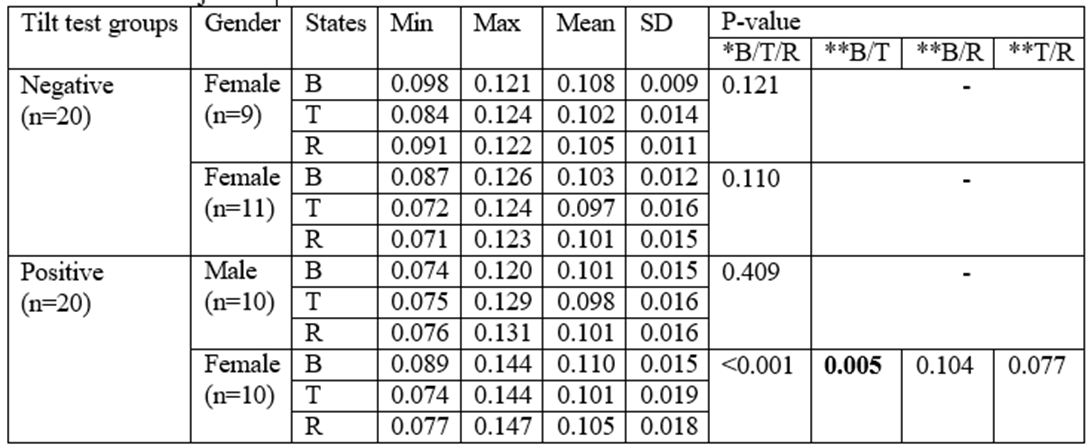
Table 3: presented a detailed comparison of the mean and standard deviation of QRSt values across three distinct states: baseline, tilt, and recovery. This analysis was further broken down by sex and included data for both the negative and positive TT groups.
B: baseline, T: tilt, R: recovery, Min: minimum, Max: maximum, SD: standard deviation.
*Analysis of Non-Parametric Friedman test.
**Bonferroni’s-adjusted test.
Table 4 presented a detailed comparison of the mean and standard deviation of QRSd values across three distinct states: baseline, tilt, and recovery. This analysis was further broken down by sex and included data for both the negative and positive TT groups.
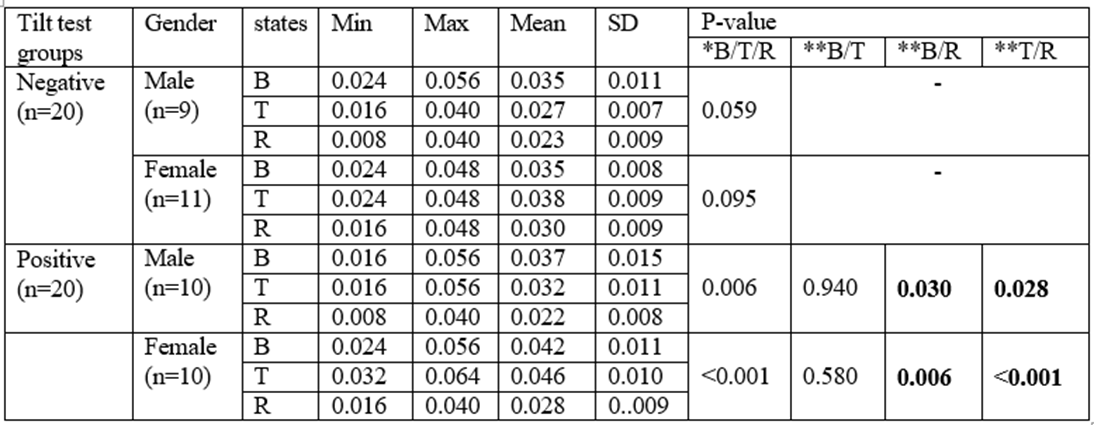
Table 4: Comparison of the mean ± standard deviation of QRSd during the baseline, tilt, and recovery states between sexes in positive and negative TT groups (n=40).
B: baseline, T: tilt, R: recovery, Min: minimum, Max: maximum, SD: standard deviation.
*Analysis of Non-Parametric Friedman test.
**Bonferroni’s-adjusted test.
In women with positive TT, the QRSt had a significant difference between baseline and tilt (P=0.005). In men with positive TT, there was no significant difference. In both sexes with positive TT, the QRSd had statistically significant difference between the baseline and recovery and between tilt and recovery (P<0>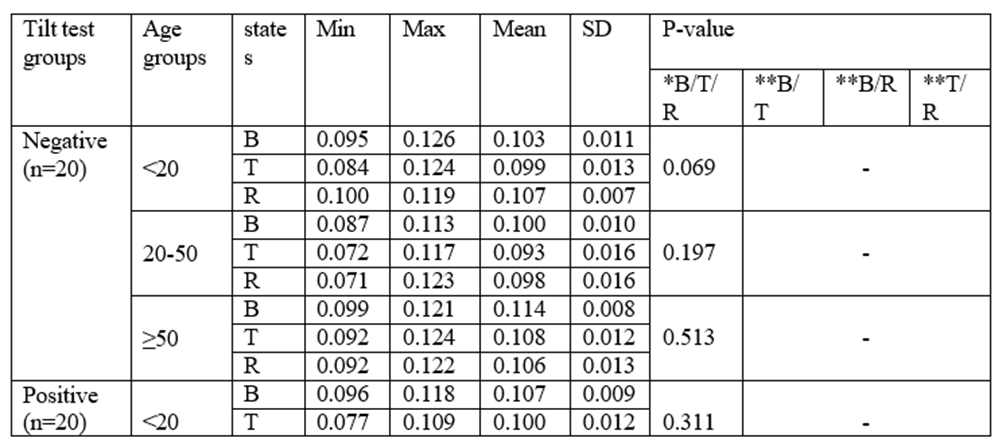
Table 5: Presented the mean and standard deviation of QRSt values across three distinct states: baseline, tilt, and recovery.
This analysis was further broken down by age clusters and included data for both the negative and positive TT groups.
B: baseline, T: tilt, R: recovery, Min: minimum, Max: maximum, SD: standard deviation.
*Analysis of Non-Parametric Friedman test.
**Bonferroni’s-adjusted test.
Table 6: presented the mean and standard deviation of QRSd values across three distinct states: baseline, tilt, and recovery.
This analysis was further broken down by age clusters and included data for both the negative and positive TT groups.
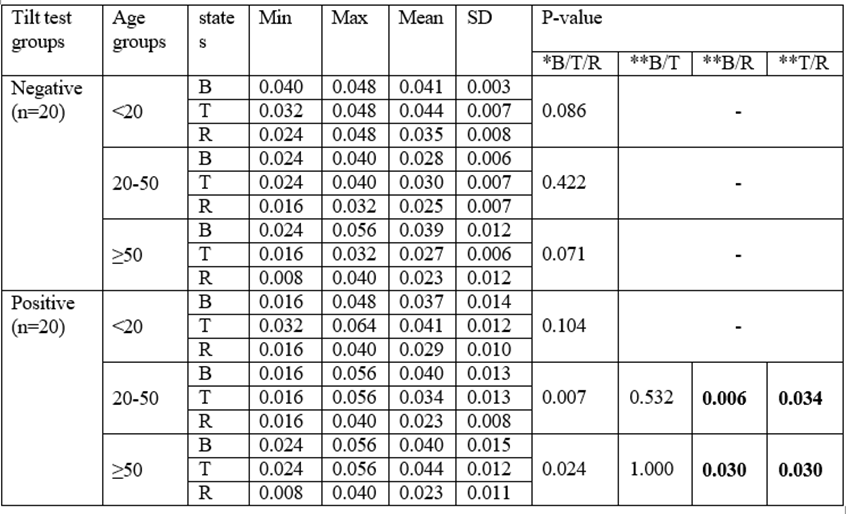
Table 6: Comparison of the mean ± standard deviation of QRSd during the baseline, tilt, and recovery states among age clusters in positive and negative TT groups (n=40).
B: baseline, T: tilt, R: recovery, Min: minimum, Max: maximum, SD: standard deviation.
*Analysis of Non-Parametric Friedman test.
**Bonferroni’s-adjusted test.
In patients aged older than 20 years who had positive TT, the QRSt had statistically significant difference between the baseline and tilt. In patients aged 20 to 50 years the QRSt had also statistically significant difference between the tilt and recovery (P<0>
There were 10 women (50%) and 10 men (50%) in the positive TT group and 11 women (55%) and 9 men (45%) in the negative TT group. The mean ± standard deviation of age were 32.55±19.28 and 32.40±18.93 years in positive and negative TT groups respectively. There was no statistically significant difference between the baseline values of QRSt and QRSd among positive and negative TT groups. The mean and standard deviation of QRSt and QRSd in baseline, tilt, and recovery states are shown in Tables 1 and 2, respectively

Table 1: Comparison of the mean ± standard deviation of QRSt during the baseline, tilt, and recovery states in positive and negative TT groups (n=40).
Non-Parametric Friedman test.
**Bonferroni’s-adjusted test.
B: baseline, T: tilt, R: recovery, Min: minimum, Max: maximum, SD: standard deviation.

Table 2: Comparison of the mean ± standard deviation of QRSd during the baseline, tilt, and recovery states in positive and negative TT groups (n=40).
B: baseline, T: tilt, R: recovery, Min: minimum, Max: maximum, SD: standard deviation.
*Analysis of Non-Parametric Friedman test.
**Bonferroni’s-adjusted test.
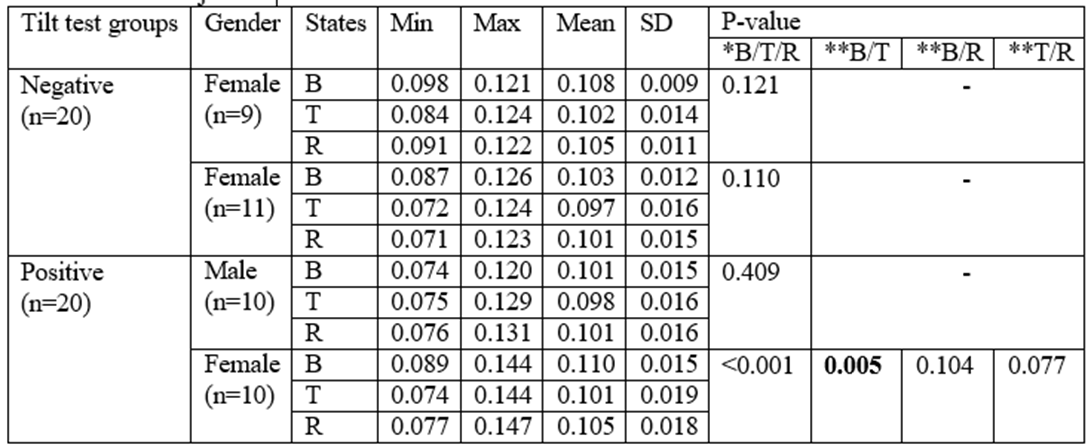
Table 3: presented a detailed comparison of the mean and standard deviation of QRSt values across three distinct states: baseline, tilt, and recovery. This analysis was further broken down by sex and included data for both the negative and positive TT groups.
B: baseline, T: tilt, R: recovery, Min: minimum, Max: maximum, SD: standard deviation.
*Analysis of Non-Parametric Friedman test.
**Bonferroni’s-adjusted test.
Table 4 presented a detailed comparison of the mean and standard deviation of QRSd values across three distinct states: baseline, tilt, and recovery. This analysis was further broken down by sex and included data for both the negative and positive TT groups.
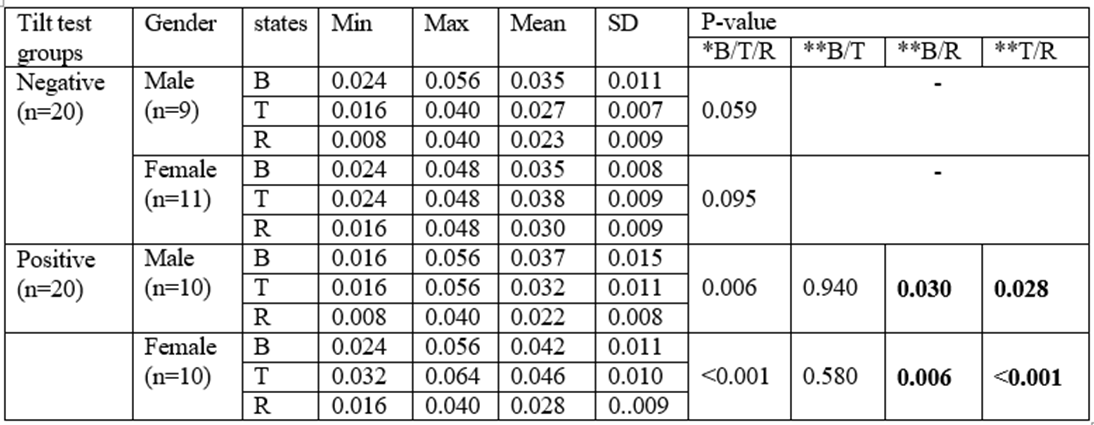
Table 4: Comparison of the mean ± standard deviation of QRSd during the baseline, tilt, and recovery states between sexes in positive and negative TT groups (n=40).
B: baseline, T: tilt, R: recovery, Min: minimum, Max: maximum, SD: standard deviation.
*Analysis of Non-Parametric Friedman test.
**Bonferroni’s-adjusted test.
In women with positive TT, the QRSt had a significant difference between baseline and tilt (P=0.005). In men with positive TT, there was no significant difference. In both sexes with positive TT, the QRSd had statistically significant difference between the baseline and recovery and between tilt and recovery (P<0>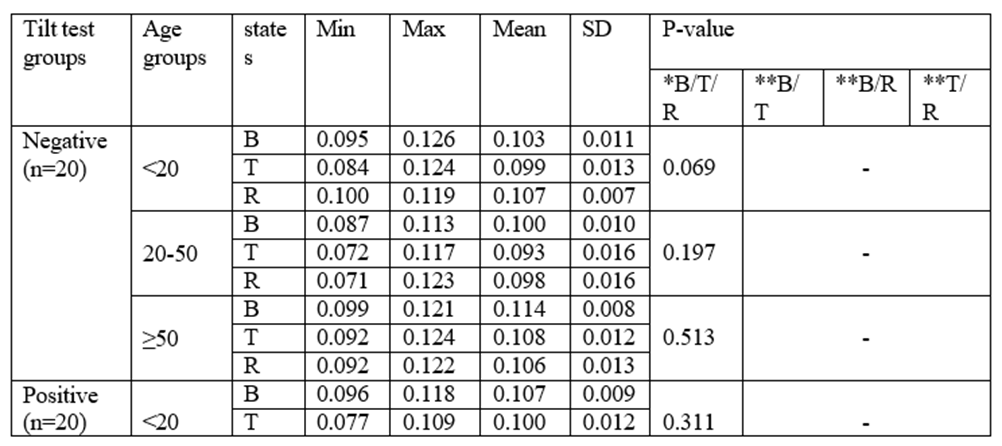
Table 5: Presented the mean and standard deviation of QRSt values across three distinct states: baseline, tilt, and recovery.
This analysis was further broken down by age clusters and included data for both the negative and positive TT groups.
B: baseline, T: tilt, R: recovery, Min: minimum, Max: maximum, SD: standard deviation.
*Analysis of Non-Parametric Friedman test.
**Bonferroni’s-adjusted test.
Table 6: presented the mean and standard deviation of QRSd values across three distinct states: baseline, tilt, and recovery.
This analysis was further broken down by age clusters and included data for both the negative and positive TT groups.
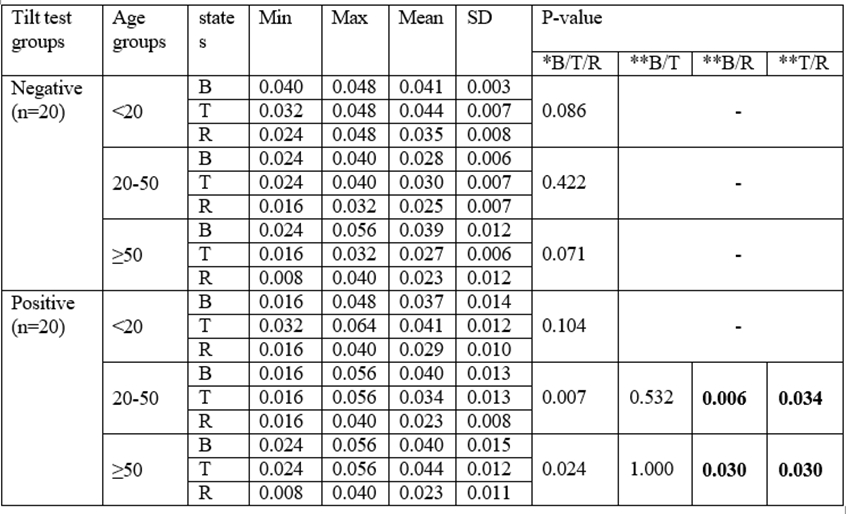
Table 6: Comparison of the mean ± standard deviation of QRSd during the baseline, tilt, and recovery states among age clusters in positive and negative TT groups (n=40).
B: baseline, T: tilt, R: recovery, Min: minimum, Max: maximum, SD: standard deviation.
*Analysis of Non-Parametric Friedman test.
**Bonferroni’s-adjusted test.
In patients aged older than 20 years who had positive TT, the QRSt had statistically significant difference between the baseline and tilt. In patients aged 20 to 50 years the QRSt had also statistically significant difference between the tilt and recovery (P<0>
This study encompassed a total of 40 patient records, which were categorized into two equal groups: 20 individuals exhibiting a positive tilt test and 20 individuals displaying a negative tilt test. The groups were meticulously matched for age and gender to ensure comparability. In the positive TT group, only females showed significant differences in the QRSt, while both sexes exhibited significant differences in the QRSd among baseline, tilt and recovery states. In the negative TT group, the comparison of QRSt and QRSd between sexes and among age clusters hag no significant differences.
In a study conducted by Picchirillo et al. involving 20 healthy subjects, it was found that the TT was associated with changes in certain electrophysiological parameters of the ECG. These changes were linked to increased sympathetic activity and other hemodynamic reflexes. The study reported no significant difference in the duration of the QRS complex; however, both the QT and ST intervals showed an increase. TT temporarily alters the sympathovagal tone, but in healthy subjects, the depolarization indices, including QRS duration and dispersion, as well as intraventricular conduction velocity, did not exhibit significant variations in response to TT. Nonetheless, most repolarization indices showed increased dispersion during TT. The discrepancies between the findings of this study and our own may be attributed to differences in the sample populations. In our study, we assessed patients on a tilt table to investigate the causes of syncope or positional dizziness, while Picchirillo et al. focused on healthy subjects [15]. When interpreting QRSd, it is important to consider the effect of wave amplitude and its relationship to the duration of the complex. Experimental studies have suggested that variations in heart size, attributed to differences in body weight, could influence this phenomenon. However, recent research has emphasized a lack of correlation between body weight and most ECG electrophysiological indices excluding the QRS duration [16, 17, 18]. Additionally, it has been reported that as QRS duration increases, the dispersion index (QRSd) also rises. The QRS duration is a key indicator for assessing intraventricular conduction time. While QRSd reflects ventricular conduction heterogeneity, some recent studies have challenged the connection between this index and the occurrence of cardiac arrhythmias due to underlying heart tissue disorders, instead linking it purely to the increase in QRS duration 919]. It appears that different mechanisms contribute to the dispersion of the QRS complex (QRSd), and their significance may vary across various diseases, leading to differing outcomes in studies. Some researchers have attributed the primary mechanism behind QRSd to the non-uniformity in the propagation of electrical impulses throughout the myocardial thickness. This phenomenon is particularly evident in cases where the QRS time is not prolonged. They suggest that the best explanation for QRSd is the uneven transmission of the ventricular depolarization impulse in relation to the axes used to record the impulses [20]. Heart rhythm disorders are not equally prevalent in both sexes, and the differences in these disorders between genders are well-documented. These differences are largely attributed to the effects of sex hormones on the heart's electrophysiological characteristics. Notably, hormones influence the expression and function of ion channel genes, while the autonomic nervous system and cardiac sympathovagal tone also interact with sex hormones, contributing to these variations.
However, there is limited information regarding how differences in body size and body fat percentage affect the electrophysiological characteristics of the cardiovascular system. Certain electrocardiographic indices, such as heart rate, RR intervals, and QT intervals, vary between women and men. Importantly, these differences cannot be solely explained by variations in body mass index or body surface area between the sexes (16). In the present study, a significant difference was found in the QRSd among patients with a positive TT in both men and women. Furthermore, the QRSt difference was observed exclusively in women within the positive TT group under the three studied conditions.
When generalizing the results of this study, several limitations should be acknowledged. Firstly, the small sample size and the retrospective design of the study are significant factors. Additionally, another limitation was the non-continuous recording of blood pressure and ECG measurements of patients during the baseline, tilt, and recovery states of the TT. Future studies could benefit from continuous monitoring of these parameters, a larger sample size, and improved matching of groups to yield more robust data and results.
Patients with positive and negative TT have different QRSd changes. TT-induced QRSd changes may be sex and age- dependent. Hemodynamic-autonomic reflexes during TT are associated with increased inhomogeneity of conduction velocity during ventricular depolarization
Please use this standard disclosure: The authors declared no conflicts of interest. No funding was received for this study.
The authors wish to thank all patients who participated in the study. This study was the result of a Doctor of Medicine Degree thesis.
This observational study was confirmed by the institutional review board standards at the Golestan University of Medical Sciences, Gorgan, Iran.
Habibizadeh K searched the literature, performed the data collection, contributed to manuscript preparation; Esmaeili H did clinical examination of the participants, contributed to data collection and edited the manuscript; Vakili MA analysed data, contributed to manuscript preparation; Hosseini SM designed the research, performed the data collection, analysed data, wrote the paper.
Clearly Auctoresonline and particularly Psychology and Mental Health Care Journal is dedicated to improving health care services for individuals and populations. The editorial boards' ability to efficiently recognize and share the global importance of health literacy with a variety of stakeholders. Auctoresonline publishing platform can be used to facilitate of optimal client-based services and should be added to health care professionals' repertoire of evidence-based health care resources.

Journal of Clinical Cardiology and Cardiovascular Intervention The submission and review process was adequate. However I think that the publication total value should have been enlightened in early fases. Thank you for all.

Journal of Women Health Care and Issues By the present mail, I want to say thank to you and tour colleagues for facilitating my published article. Specially thank you for the peer review process, support from the editorial office. I appreciate positively the quality of your journal.
Journal of Clinical Research and Reports I would be very delighted to submit my testimonial regarding the reviewer board and the editorial office. The reviewer board were accurate and helpful regarding any modifications for my manuscript. And the editorial office were very helpful and supportive in contacting and monitoring with any update and offering help. It was my pleasure to contribute with your promising Journal and I am looking forward for more collaboration.

We would like to thank the Journal of Thoracic Disease and Cardiothoracic Surgery because of the services they provided us for our articles. The peer-review process was done in a very excellent time manner, and the opinions of the reviewers helped us to improve our manuscript further. The editorial office had an outstanding correspondence with us and guided us in many ways. During a hard time of the pandemic that is affecting every one of us tremendously, the editorial office helped us make everything easier for publishing scientific work. Hope for a more scientific relationship with your Journal.

The peer-review process which consisted high quality queries on the paper. I did answer six reviewers’ questions and comments before the paper was accepted. The support from the editorial office is excellent.

Journal of Neuroscience and Neurological Surgery. I had the experience of publishing a research article recently. The whole process was simple from submission to publication. The reviewers made specific and valuable recommendations and corrections that improved the quality of my publication. I strongly recommend this Journal.

Dr. Katarzyna Byczkowska My testimonial covering: "The peer review process is quick and effective. The support from the editorial office is very professional and friendly. Quality of the Clinical Cardiology and Cardiovascular Interventions is scientific and publishes ground-breaking research on cardiology that is useful for other professionals in the field.

Thank you most sincerely, with regard to the support you have given in relation to the reviewing process and the processing of my article entitled "Large Cell Neuroendocrine Carcinoma of The Prostate Gland: A Review and Update" for publication in your esteemed Journal, Journal of Cancer Research and Cellular Therapeutics". The editorial team has been very supportive.

Testimony of Journal of Clinical Otorhinolaryngology: work with your Reviews has been a educational and constructive experience. The editorial office were very helpful and supportive. It was a pleasure to contribute to your Journal.

Dr. Bernard Terkimbi Utoo, I am happy to publish my scientific work in Journal of Women Health Care and Issues (JWHCI). The manuscript submission was seamless and peer review process was top notch. I was amazed that 4 reviewers worked on the manuscript which made it a highly technical, standard and excellent quality paper. I appreciate the format and consideration for the APC as well as the speed of publication. It is my pleasure to continue with this scientific relationship with the esteem JWHCI.

This is an acknowledgment for peer reviewers, editorial board of Journal of Clinical Research and Reports. They show a lot of consideration for us as publishers for our research article “Evaluation of the different factors associated with side effects of COVID-19 vaccination on medical students, Mutah university, Al-Karak, Jordan”, in a very professional and easy way. This journal is one of outstanding medical journal.
Dear Hao Jiang, to Journal of Nutrition and Food Processing We greatly appreciate the efficient, professional and rapid processing of our paper by your team. If there is anything else we should do, please do not hesitate to let us know. On behalf of my co-authors, we would like to express our great appreciation to editor and reviewers.

As an author who has recently published in the journal "Brain and Neurological Disorders". I am delighted to provide a testimonial on the peer review process, editorial office support, and the overall quality of the journal. The peer review process at Brain and Neurological Disorders is rigorous and meticulous, ensuring that only high-quality, evidence-based research is published. The reviewers are experts in their fields, and their comments and suggestions were constructive and helped improve the quality of my manuscript. The review process was timely and efficient, with clear communication from the editorial office at each stage. The support from the editorial office was exceptional throughout the entire process. The editorial staff was responsive, professional, and always willing to help. They provided valuable guidance on formatting, structure, and ethical considerations, making the submission process seamless. Moreover, they kept me informed about the status of my manuscript and provided timely updates, which made the process less stressful. The journal Brain and Neurological Disorders is of the highest quality, with a strong focus on publishing cutting-edge research in the field of neurology. The articles published in this journal are well-researched, rigorously peer-reviewed, and written by experts in the field. The journal maintains high standards, ensuring that readers are provided with the most up-to-date and reliable information on brain and neurological disorders. In conclusion, I had a wonderful experience publishing in Brain and Neurological Disorders. The peer review process was thorough, the editorial office provided exceptional support, and the journal's quality is second to none. I would highly recommend this journal to any researcher working in the field of neurology and brain disorders.

Dear Agrippa Hilda, Journal of Neuroscience and Neurological Surgery, Editorial Coordinator, I trust this message finds you well. I want to extend my appreciation for considering my article for publication in your esteemed journal. I am pleased to provide a testimonial regarding the peer review process and the support received from your editorial office. The peer review process for my paper was carried out in a highly professional and thorough manner. The feedback and comments provided by the authors were constructive and very useful in improving the quality of the manuscript. This rigorous assessment process undoubtedly contributes to the high standards maintained by your journal.

International Journal of Clinical Case Reports and Reviews. I strongly recommend to consider submitting your work to this high-quality journal. The support and availability of the Editorial staff is outstanding and the review process was both efficient and rigorous.

Thank you very much for publishing my Research Article titled “Comparing Treatment Outcome Of Allergic Rhinitis Patients After Using Fluticasone Nasal Spray And Nasal Douching" in the Journal of Clinical Otorhinolaryngology. As Medical Professionals we are immensely benefited from study of various informative Articles and Papers published in this high quality Journal. I look forward to enriching my knowledge by regular study of the Journal and contribute my future work in the field of ENT through the Journal for use by the medical fraternity. The support from the Editorial office was excellent and very prompt. I also welcome the comments received from the readers of my Research Article.

Dear Erica Kelsey, Editorial Coordinator of Cancer Research and Cellular Therapeutics Our team is very satisfied with the processing of our paper by your journal. That was fast, efficient, rigorous, but without unnecessary complications. We appreciated the very short time between the submission of the paper and its publication on line on your site.

I am very glad to say that the peer review process is very successful and fast and support from the Editorial Office. Therefore, I would like to continue our scientific relationship for a long time. And I especially thank you for your kindly attention towards my article. Have a good day!

"We recently published an article entitled “Influence of beta-Cyclodextrins upon the Degradation of Carbofuran Derivatives under Alkaline Conditions" in the Journal of “Pesticides and Biofertilizers” to show that the cyclodextrins protect the carbamates increasing their half-life time in the presence of basic conditions This will be very helpful to understand carbofuran behaviour in the analytical, agro-environmental and food areas. We greatly appreciated the interaction with the editor and the editorial team; we were particularly well accompanied during the course of the revision process, since all various steps towards publication were short and without delay".

I would like to express my gratitude towards you process of article review and submission. I found this to be very fair and expedient. Your follow up has been excellent. I have many publications in national and international journal and your process has been one of the best so far. Keep up the great work.

We are grateful for this opportunity to provide a glowing recommendation to the Journal of Psychiatry and Psychotherapy. We found that the editorial team were very supportive, helpful, kept us abreast of timelines and over all very professional in nature. The peer review process was rigorous, efficient and constructive that really enhanced our article submission. The experience with this journal remains one of our best ever and we look forward to providing future submissions in the near future.

I am very pleased to serve as EBM of the journal, I hope many years of my experience in stem cells can help the journal from one way or another. As we know, stem cells hold great potential for regenerative medicine, which are mostly used to promote the repair response of diseased, dysfunctional or injured tissue using stem cells or their derivatives. I think Stem Cell Research and Therapeutics International is a great platform to publish and share the understanding towards the biology and translational or clinical application of stem cells.

I would like to give my testimony in the support I have got by the peer review process and to support the editorial office where they were of asset to support young author like me to be encouraged to publish their work in your respected journal and globalize and share knowledge across the globe. I really give my great gratitude to your journal and the peer review including the editorial office.

I am delighted to publish our manuscript entitled "A Perspective on Cocaine Induced Stroke - Its Mechanisms and Management" in the Journal of Neuroscience and Neurological Surgery. The peer review process, support from the editorial office, and quality of the journal are excellent. The manuscripts published are of high quality and of excellent scientific value. I recommend this journal very much to colleagues.

Dr.Tania Muñoz, My experience as researcher and author of a review article in The Journal Clinical Cardiology and Interventions has been very enriching and stimulating. The editorial team is excellent, performs its work with absolute responsibility and delivery. They are proactive, dynamic and receptive to all proposals. Supporting at all times the vast universe of authors who choose them as an option for publication. The team of review specialists, members of the editorial board, are brilliant professionals, with remarkable performance in medical research and scientific methodology. Together they form a frontline team that consolidates the JCCI as a magnificent option for the publication and review of high-level medical articles and broad collective interest. I am honored to be able to share my review article and open to receive all your comments.

“The peer review process of JPMHC is quick and effective. Authors are benefited by good and professional reviewers with huge experience in the field of psychology and mental health. The support from the editorial office is very professional. People to contact to are friendly and happy to help and assist any query authors might have. Quality of the Journal is scientific and publishes ground-breaking research on mental health that is useful for other professionals in the field”.

Dear editorial department: On behalf of our team, I hereby certify the reliability and superiority of the International Journal of Clinical Case Reports and Reviews in the peer review process, editorial support, and journal quality. Firstly, the peer review process of the International Journal of Clinical Case Reports and Reviews is rigorous, fair, transparent, fast, and of high quality. The editorial department invites experts from relevant fields as anonymous reviewers to review all submitted manuscripts. These experts have rich academic backgrounds and experience, and can accurately evaluate the academic quality, originality, and suitability of manuscripts. The editorial department is committed to ensuring the rigor of the peer review process, while also making every effort to ensure a fast review cycle to meet the needs of authors and the academic community. Secondly, the editorial team of the International Journal of Clinical Case Reports and Reviews is composed of a group of senior scholars and professionals with rich experience and professional knowledge in related fields. The editorial department is committed to assisting authors in improving their manuscripts, ensuring their academic accuracy, clarity, and completeness. Editors actively collaborate with authors, providing useful suggestions and feedback to promote the improvement and development of the manuscript. We believe that the support of the editorial department is one of the key factors in ensuring the quality of the journal. Finally, the International Journal of Clinical Case Reports and Reviews is renowned for its high- quality articles and strict academic standards. The editorial department is committed to publishing innovative and academically valuable research results to promote the development and progress of related fields. The International Journal of Clinical Case Reports and Reviews is reasonably priced and ensures excellent service and quality ratio, allowing authors to obtain high-level academic publishing opportunities in an affordable manner. I hereby solemnly declare that the International Journal of Clinical Case Reports and Reviews has a high level of credibility and superiority in terms of peer review process, editorial support, reasonable fees, and journal quality. Sincerely, Rui Tao.

Clinical Cardiology and Cardiovascular Interventions I testity the covering of the peer review process, support from the editorial office, and quality of the journal.

Clinical Cardiology and Cardiovascular Interventions, we deeply appreciate the interest shown in our work and its publication. It has been a true pleasure to collaborate with you. The peer review process, as well as the support provided by the editorial office, have been exceptional, and the quality of the journal is very high, which was a determining factor in our decision to publish with you.
The peer reviewers process is quick and effective, the supports from editorial office is excellent, the quality of journal is high. I would like to collabroate with Internatioanl journal of Clinical Case Reports and Reviews journal clinically in the future time.

Clinical Cardiology and Cardiovascular Interventions, I would like to express my sincerest gratitude for the trust placed in our team for the publication in your journal. It has been a true pleasure to collaborate with you on this project. I am pleased to inform you that both the peer review process and the attention from the editorial coordination have been excellent. Your team has worked with dedication and professionalism to ensure that your publication meets the highest standards of quality. We are confident that this collaboration will result in mutual success, and we are eager to see the fruits of this shared effort.

Dear Dr. Jessica Magne, Editorial Coordinator 0f Clinical Cardiology and Cardiovascular Interventions, I hope this message finds you well. I want to express my utmost gratitude for your excellent work and for the dedication and speed in the publication process of my article titled "Navigating Innovation: Qualitative Insights on Using Technology for Health Education in Acute Coronary Syndrome Patients." I am very satisfied with the peer review process, the support from the editorial office, and the quality of the journal. I hope we can maintain our scientific relationship in the long term.
Dear Monica Gissare, - Editorial Coordinator of Nutrition and Food Processing. ¨My testimony with you is truly professional, with a positive response regarding the follow-up of the article and its review, you took into account my qualities and the importance of the topic¨.

Dear Dr. Jessica Magne, Editorial Coordinator 0f Clinical Cardiology and Cardiovascular Interventions, The review process for the article “The Handling of Anti-aggregants and Anticoagulants in the Oncologic Heart Patient Submitted to Surgery” was extremely rigorous and detailed. From the initial submission to the final acceptance, the editorial team at the “Journal of Clinical Cardiology and Cardiovascular Interventions” demonstrated a high level of professionalism and dedication. The reviewers provided constructive and detailed feedback, which was essential for improving the quality of our work. Communication was always clear and efficient, ensuring that all our questions were promptly addressed. The quality of the “Journal of Clinical Cardiology and Cardiovascular Interventions” is undeniable. It is a peer-reviewed, open-access publication dedicated exclusively to disseminating high-quality research in the field of clinical cardiology and cardiovascular interventions. The journal's impact factor is currently under evaluation, and it is indexed in reputable databases, which further reinforces its credibility and relevance in the scientific field. I highly recommend this journal to researchers looking for a reputable platform to publish their studies.

Dear Editorial Coordinator of the Journal of Nutrition and Food Processing! "I would like to thank the Journal of Nutrition and Food Processing for including and publishing my article. The peer review process was very quick, movement and precise. The Editorial Board has done an extremely conscientious job with much help, valuable comments and advices. I find the journal very valuable from a professional point of view, thank you very much for allowing me to be part of it and I would like to participate in the future!”

Dealing with The Journal of Neurology and Neurological Surgery was very smooth and comprehensive. The office staff took time to address my needs and the response from editors and the office was prompt and fair. I certainly hope to publish with this journal again.Their professionalism is apparent and more than satisfactory. Susan Weiner

My Testimonial Covering as fellowing: Lin-Show Chin. The peer reviewers process is quick and effective, the supports from editorial office is excellent, the quality of journal is high. I would like to collabroate with Internatioanl journal of Clinical Case Reports and Reviews.

My experience publishing in Psychology and Mental Health Care was exceptional. The peer review process was rigorous and constructive, with reviewers providing valuable insights that helped enhance the quality of our work. The editorial team was highly supportive and responsive, making the submission process smooth and efficient. The journal's commitment to high standards and academic rigor makes it a respected platform for quality research. I am grateful for the opportunity to publish in such a reputable journal.
My experience publishing in International Journal of Clinical Case Reports and Reviews was exceptional. I Come forth to Provide a Testimonial Covering the Peer Review Process and the editorial office for the Professional and Impartial Evaluation of the Manuscript.

I would like to offer my testimony in the support. I have received through the peer review process and support the editorial office where they are to support young authors like me, encourage them to publish their work in your esteemed journals, and globalize and share knowledge globally. I really appreciate your journal, peer review, and editorial office.
Dear Agrippa Hilda- Editorial Coordinator of Journal of Neuroscience and Neurological Surgery, "The peer review process was very quick and of high quality, which can also be seen in the articles in the journal. The collaboration with the editorial office was very good."

I would like to express my sincere gratitude for the support and efficiency provided by the editorial office throughout the publication process of my article, “Delayed Vulvar Metastases from Rectal Carcinoma: A Case Report.” I greatly appreciate the assistance and guidance I received from your team, which made the entire process smooth and efficient. The peer review process was thorough and constructive, contributing to the overall quality of the final article. I am very grateful for the high level of professionalism and commitment shown by the editorial staff, and I look forward to maintaining a long-term collaboration with the International Journal of Clinical Case Reports and Reviews.
To Dear Erin Aust, I would like to express my heartfelt appreciation for the opportunity to have my work published in this esteemed journal. The entire publication process was smooth and well-organized, and I am extremely satisfied with the final result. The Editorial Team demonstrated the utmost professionalism, providing prompt and insightful feedback throughout the review process. Their clear communication and constructive suggestions were invaluable in enhancing my manuscript, and their meticulous attention to detail and dedication to quality are truly commendable. Additionally, the support from the Editorial Office was exceptional. From the initial submission to the final publication, I was guided through every step of the process with great care and professionalism. The team's responsiveness and assistance made the entire experience both easy and stress-free. I am also deeply impressed by the quality and reputation of the journal. It is an honor to have my research featured in such a respected publication, and I am confident that it will make a meaningful contribution to the field.

"I am grateful for the opportunity of contributing to [International Journal of Clinical Case Reports and Reviews] and for the rigorous review process that enhances the quality of research published in your esteemed journal. I sincerely appreciate the time and effort of your team who have dedicatedly helped me in improvising changes and modifying my manuscript. The insightful comments and constructive feedback provided have been invaluable in refining and strengthening my work".

I thank the ‘Journal of Clinical Research and Reports’ for accepting this article for publication. This is a rigorously peer reviewed journal which is on all major global scientific data bases. I note the review process was prompt, thorough and professionally critical. It gave us an insight into a number of important scientific/statistical issues. The review prompted us to review the relevant literature again and look at the limitations of the study. The peer reviewers were open, clear in the instructions and the editorial team was very prompt in their communication. This journal certainly publishes quality research articles. I would recommend the journal for any future publications.

Dear Jessica Magne, with gratitude for the joint work. Fast process of receiving and processing the submitted scientific materials in “Clinical Cardiology and Cardiovascular Interventions”. High level of competence of the editors with clear and correct recommendations and ideas for enriching the article.

We found the peer review process quick and positive in its input. The support from the editorial officer has been very agile, always with the intention of improving the article and taking into account our subsequent corrections.

My article, titled 'No Way Out of the Smartphone Epidemic Without Considering the Insights of Brain Research,' has been republished in the International Journal of Clinical Case Reports and Reviews. The review process was seamless and professional, with the editors being both friendly and supportive. I am deeply grateful for their efforts.
To Dear Erin Aust – Editorial Coordinator of Journal of General Medicine and Clinical Practice! I declare that I am absolutely satisfied with your work carried out with great competence in following the manuscript during the various stages from its receipt, during the revision process to the final acceptance for publication. Thank Prof. Elvira Farina
